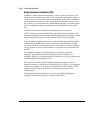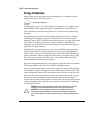
Glossary-1
Glossary
10BaseT – Unshielded twisted pair cable used to connect computers on an
Ethernet network. See Ethernet.
American National Standards Institute (ANSI) – A private, non-profit
organization that facilitates the development of national technical standards by
establishing consensus among qualified public and private sector groups.
American Standard Code for Information Interchange (ASCII) – The code
used to represent the conversion of keyboard characters into binary digits that can
be processed by the computer. See American National Standards Institute.
analog – A continuous electronic current of varying frequency. Digital data from a
computer must be converted to an analog signal by a modem before it can be
transmitted over standard telephone lines. Contrast digital.
ANSI – See American National Standards Institute.
anti-virus utility – A program that detects and in many cases repairs the damage
caused by harmful program code. See virus, utility.
application – A software program that facilitates the performance of useful work,
such as a word processing program.
ASCII – See American Standard Code for Information Interchange.
backup – A copy of one or more files for safekeeping.
Basic Input Output System (BIOS) – An instruction set stored on the read-only
memory chip of a computer that handles how the hardware reacts to commands
from software.
binary – A number system that uses only the symbols 0 and 1. Used to represent
digital data.
binary digit – A representation of the basic building block of all computer
information using the symbols 0 and 1. The data represented by one binary digit is
equal to one bit. See bit, byte.
BIOS – See Basic Input Output System.
bit – A unit of measurement used to describe the smallest possible piece of
computer information, represented as a binary digit. Eight bits is equal to one byte.
See byte; binary digit.


















